Input interpretation

SMILES: CsBr
Basic properties
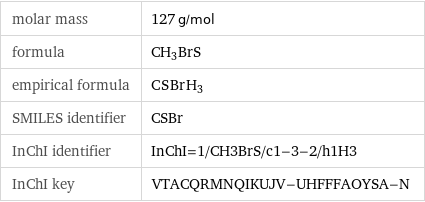
molar mass | 127 g/mol formula | CH_3BrS empirical formula | C_S_Br_H_3 SMILES identifier | CSBr InChI identifier | InChI=1/CH3BrS/c1-3-2/h1H3 InChI key | VTACQRMNQIKUJV-UHFFFAOYSA-N
Lewis structure
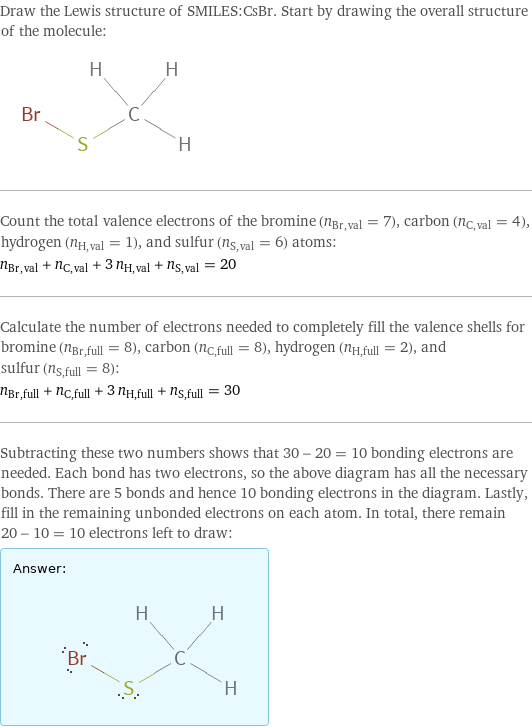
Draw the Lewis structure of SMILES:CsBr. Start by drawing the overall structure of the molecule: Count the total valence electrons of the bromine (n_Br, val = 7), carbon (n_C, val = 4), hydrogen (n_H, val = 1), and sulfur (n_S, val = 6) atoms: n_Br, val + n_C, val + 3 n_H, val + n_S, val = 20 Calculate the number of electrons needed to completely fill the valence shells for bromine (n_Br, full = 8), carbon (n_C, full = 8), hydrogen (n_H, full = 2), and sulfur (n_S, full = 8): n_Br, full + n_C, full + 3 n_H, full + n_S, full = 30 Subtracting these two numbers shows that 30 - 20 = 10 bonding electrons are needed. Each bond has two electrons, so the above diagram has all the necessary bonds. There are 5 bonds and hence 10 bonding electrons in the diagram. Lastly, fill in the remaining unbonded electrons on each atom. In total, there remain 20 - 10 = 10 electrons left to draw: Answer: | |
Estimated thermodynamic properties
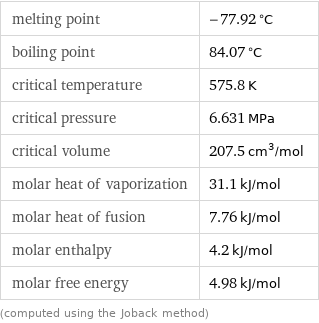
melting point | -77.92 °C boiling point | 84.07 °C critical temperature | 575.8 K critical pressure | 6.631 MPa critical volume | 207.5 cm^3/mol molar heat of vaporization | 31.1 kJ/mol molar heat of fusion | 7.76 kJ/mol molar enthalpy | 4.2 kJ/mol molar free energy | 4.98 kJ/mol (computed using the Joback method)
Units

Quantitative molecular descriptors

longest chain length | 3 atoms longest straight chain length | 3 atoms longest aliphatic chain length | 0 atoms aromatic atom count | 0 atoms H-bond acceptor count | 0 atoms H-bond donor count | 0 atoms
Elemental composition

Find the elemental composition for SMILES:CsBr in terms of the atom and mass percents: atom percent = N_i/N_total × 100% mass percent = (N_im_i)/m × 100% Plan: • Write the chemical formula and gather atomic masses from the periodic table. • Determine values for N_i, m_i, N_total and m using these items. • Finally, compute the percents and check the results. Write the chemical formula: CH_3BrS Use the chemical formula to count the number of atoms, N_i, for each element and find the total number of atoms, N_total: | number of atoms C (carbon) | 1 S (sulfur) | 1 Br (bromine) | 1 H (hydrogen) | 3 N_total = 1 + 1 + 1 + 3 = 6 Divide each N_i by N_total to calculate atom fractions. Then use the property that atom fractions must sum to one to check the work: | number of atoms | atom fraction C (carbon) | 1 | 1/6 S (sulfur) | 1 | 1/6 Br (bromine) | 1 | 1/6 H (hydrogen) | 3 | 3/6 Check: 1/6 + 1/6 + 1/6 + 3/6 = 1 Compute atom percents using the atom fractions: | number of atoms | atom percent C (carbon) | 1 | 1/6 × 100% = 16.7% S (sulfur) | 1 | 1/6 × 100% = 16.7% Br (bromine) | 1 | 1/6 × 100% = 16.7% H (hydrogen) | 3 | 3/6 × 100% = 50.0% Look up the atomic mass, m_i, in unified atomic mass units, u, for each element in the periodic table: | number of atoms | atom percent | atomic mass/u C (carbon) | 1 | 16.7% | 12.011 S (sulfur) | 1 | 16.7% | 32.06 Br (bromine) | 1 | 16.7% | 79.904 H (hydrogen) | 3 | 50.0% | 1.008 Multiply N_i by m_i to compute the mass for each element. Then sum those values to compute the molecular mass, m: | number of atoms | atom percent | atomic mass/u | mass/u C (carbon) | 1 | 16.7% | 12.011 | 1 × 12.011 = 12.011 S (sulfur) | 1 | 16.7% | 32.06 | 1 × 32.06 = 32.06 Br (bromine) | 1 | 16.7% | 79.904 | 1 × 79.904 = 79.904 H (hydrogen) | 3 | 50.0% | 1.008 | 3 × 1.008 = 3.024 m = 12.011 u + 32.06 u + 79.904 u + 3.024 u = 126.999 u Divide the mass for each element by m to calculate mass fractions. Then use the property that mass fractions must sum to one to check the work: | number of atoms | atom percent | mass fraction C (carbon) | 1 | 16.7% | 12.011/126.999 S (sulfur) | 1 | 16.7% | 32.06/126.999 Br (bromine) | 1 | 16.7% | 79.904/126.999 H (hydrogen) | 3 | 50.0% | 3.024/126.999 Check: 12.011/126.999 + 32.06/126.999 + 79.904/126.999 + 3.024/126.999 = 1 Compute mass percents using the mass fractions: Answer: | | | number of atoms | atom percent | mass percent C (carbon) | 1 | 16.7% | 12.011/126.999 × 100% = 9.458% S (sulfur) | 1 | 16.7% | 32.06/126.999 × 100% = 25.24% Br (bromine) | 1 | 16.7% | 79.904/126.999 × 100% = 62.92% H (hydrogen) | 3 | 50.0% | 3.024/126.999 × 100% = 2.381%
Elemental oxidation states
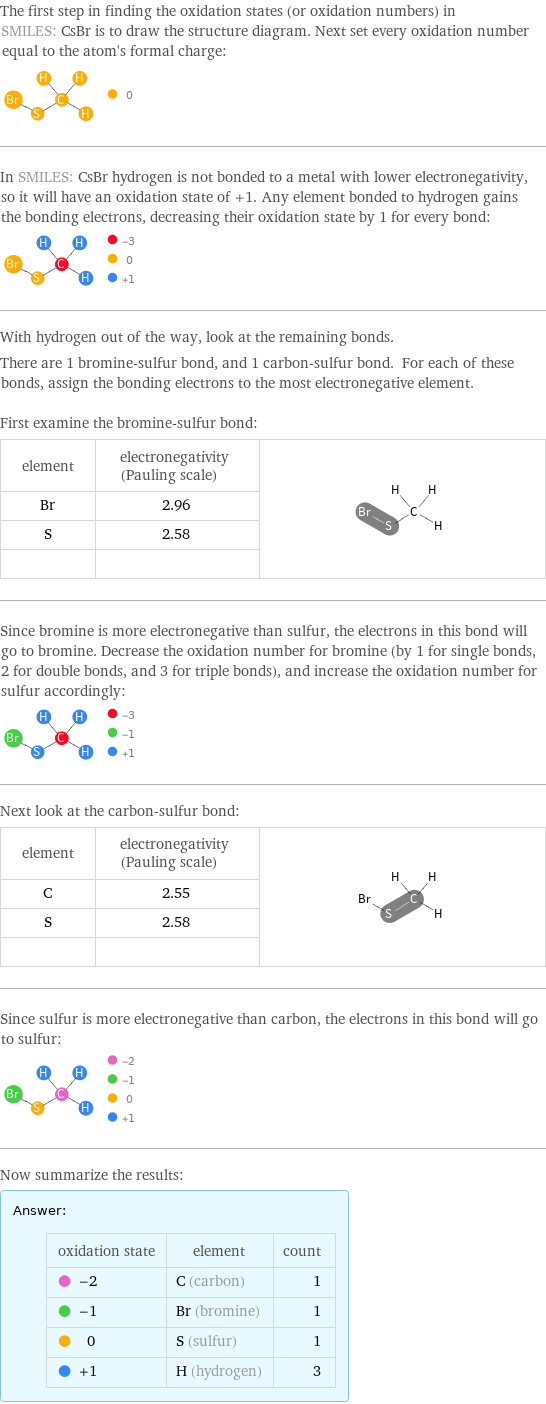
The first step in finding the oxidation states (or oxidation numbers) in SMILES: CsBr is to draw the structure diagram. Next set every oxidation number equal to the atom's formal charge: In SMILES: CsBr hydrogen is not bonded to a metal with lower electronegativity, so it will have an oxidation state of +1. Any element bonded to hydrogen gains the bonding electrons, decreasing their oxidation state by 1 for every bond: With hydrogen out of the way, look at the remaining bonds. There are 1 bromine-sulfur bond, and 1 carbon-sulfur bond. For each of these bonds, assign the bonding electrons to the most electronegative element. First examine the bromine-sulfur bond: element | electronegativity (Pauling scale) | Br | 2.96 | S | 2.58 | | | Since bromine is more electronegative than sulfur, the electrons in this bond will go to bromine. Decrease the oxidation number for bromine (by 1 for single bonds, 2 for double bonds, and 3 for triple bonds), and increase the oxidation number for sulfur accordingly: Next look at the carbon-sulfur bond: element | electronegativity (Pauling scale) | C | 2.55 | S | 2.58 | | | Since sulfur is more electronegative than carbon, the electrons in this bond will go to sulfur: Now summarize the results: Answer: | | oxidation state | element | count -2 | C (carbon) | 1 -1 | Br (bromine) | 1 0 | S (sulfur) | 1 +1 | H (hydrogen) | 3
Orbital hybridization
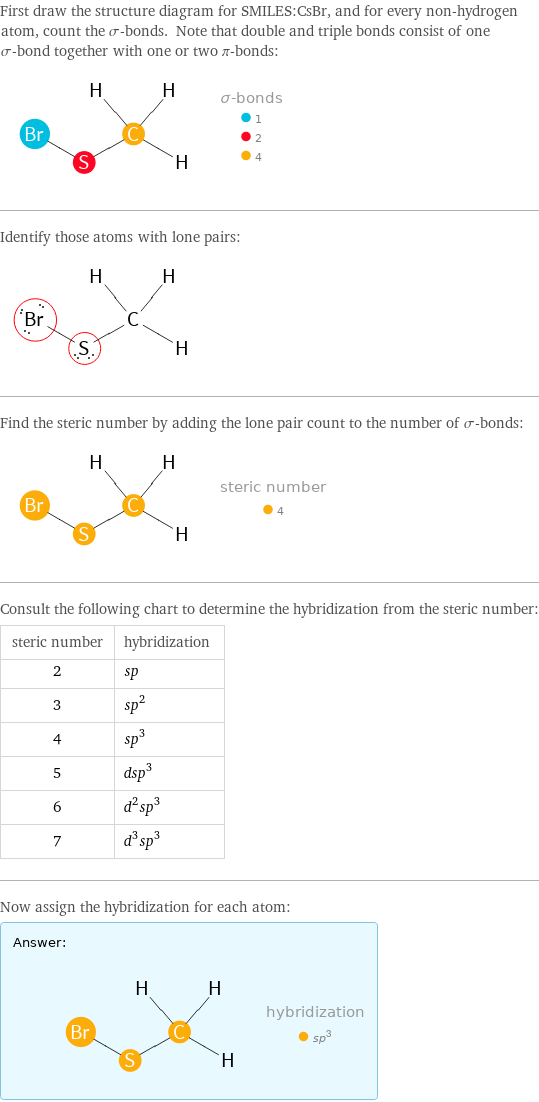
First draw the structure diagram for SMILES:CsBr, and for every non-hydrogen atom, count the σ-bonds. Note that double and triple bonds consist of one σ-bond together with one or two π-bonds: Identify those atoms with lone pairs: Find the steric number by adding the lone pair count to the number of σ-bonds: Consult the following chart to determine the hybridization from the steric number: steric number | hybridization 2 | sp 3 | sp^2 4 | sp^3 5 | dsp^3 6 | d^2sp^3 7 | d^3sp^3 Now assign the hybridization for each atom: Answer: | |
Topological indices
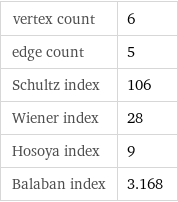
vertex count | 6 edge count | 5 Schultz index | 106 Wiener index | 28 Hosoya index | 9 Balaban index | 3.168